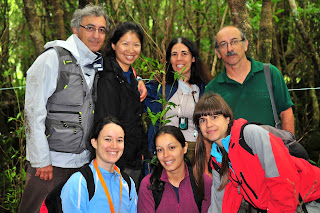An expedition in the Azores with the purpose of
sampling bryophyte communities along an elevational gradient took place between
the 4th and 12th of September 2012 in Pico island. The team
was composed by Pr. Dr. Rosalina Gabriel (local Moveclim coordinator), Dr.
Claudine Ah-Peng (Moveclim co-coordinator), Márcia Coelho (PhD student in
Azores), Silvia Aranda (PhD student in Spain), Débora Henriques (PhD student in
Azores) and by Fernando Pereira (technician in the Azores University). The
weather was good, allowing the fieldwork to proceed without
major drawbacks within 6 days. There were twelve altitudes to sample along the
gradient from 10 to 2200 m, every 200 m two permanent plots of 10 X 10 m were
set, according to the BRYOLAT methodology. From 1200 to 2200 m the sampling was
conducted in the Pico Mountain (2351 m), highest summit of Portugal, a stratovolcano that created the island 300 000 years ago.
Pix: Pico mountain (2351 m) from P. Borges.
We here briefly describe the sampling sites
and illustrate the gradient with some photographs:
·
10 m – Manhenha (Ponta da Ilha)
Vegetation is composed of shrubs (scrubland). Bryophytes
are more abundant on rocks, the canopy is low < 5m. The vascular flora is dominated
by Myrica faya, Pteridium and Erica azorica.
Pix: Manhenha, eastern point of the transect (C. Ah-Peng).
·
200 m – Cabeço da Hera
Lowland forest unfortunately disturbed with
non-native Pittosporum undulatum and Hedychium gardnerianum. Bryophytes were
mainly on the soil and on rocks.
·
400 m – Fetais (Piedade)
Forest system, the canopy is higher (maximum of
8 m). Vegetation is dominated by Pittosporum
undulatum (80%). Erica azorica, Picconia
azorica and Laurus sp. were also present but in lower quantities (15-30%).
Pix: Although highly disturbed, this site hosts the endemic moss species Echinodium renauldii, which was here reported fertile (P. Borges).
·
600 m – Caminho dos Burros (Chão Verde)
Scrubland and forest vegetation.
Pix: Chão Verde's site (C. Ah-Peng).
· 800 m – Caiado
Forest system with trees up to 4 m high.
Ilex azorica, Euphorbia sp., Juniperus brevifolia and Vaccinium cylindraceum composed the native vegetation.
· 1000 m – Caveiro
Forest system where bryophytes are present and abundant in all available substrates (soil, rock, leaves and trees). Though a natural reserve, this system is surrounded by pastures with cattle. the nearby non indigenous grassland is taking over on Sphagnum colonies.
Pix: Fernando in the vegetation of Chao Verde (C. Ah-Peng)
Pix: Hanging epiphytic bryophytes (C. Ah-Peng)
·
1200 m – Pico Mountain
Scrubland. Bryophyte cover is predominant on
rocks, at the base of shrub barks and lower branches.
The dominant vascular species is Erica azorica, followed by Vaccinium cylindraceum and Blechnum spicant.
Pix: Site at 1200 m, above the Pico information centre.
Pix: Epiphytic mosses on Erica azorica (P. Borges)
· 1400 m – Pico Mountain
Scrubland, bryophyte cover is predominant in rocks. Vascular species are < 1 m high.
Erica azorica and Calluna vulgaris dominate the plant composition, with Potentilla sp. also abundant.
Pix: Shrubby vegetation at 1400 m (P. Borges)
·
1600 m – Pico Mountain
Scrubland, similar to 1400 m.
Pix: Ericaceous vegetation at 1600 m (P. Borges)
·
1800, 2000
and 2200 m – Pico Mountain
Scrubland, bryophytes are scarce but mainly
present in rocks.
Vascular flora is also rarefied, dominated by Calluna vulgaris and Thymus caespititius, never reaching
heights superior to 0,2 m.
Pix: Lower vegetation and rocky habitats (P. Borges).
Pix: The 2200 m site, Pico peak in the background (C. Ah-Peng)
Pix: Native Calluna vulgaris, (C. Ah-Peng)
Pix: Daboecia azorica, endemic of the Azores (C. Ah-Peng)
Apart from the lowland sites, which were
disturbed with alien species, the rest of the gradient present native habitats.
Near 1000 bryophyte ecological specimens of 50 cm2 were collected
during this expedition, these samples are being air-dried and processed at the
University of Azores for identification.
Pix: The Pico's team on the last day of field work, from left to right: Paolo Borges, Claudine Ah-Peng, Rosalina Gabriel, Fernando Pereira, at the bottom, Márcia Coelho, Débora Henriques and Silvia Aranda (P. Borges)
This expedition was also the opportunity to
discuss the PhD work of the two Portuguese students who will start working on the
elevational gradients of bryophytes in the Azores, to sign the agreement
between the National Park of Pico and the University of the Azores for the
MOVECLIM project, to see the basaltic vineyard landscape which
is Unesco Word heritage Site and to visit a lava tube of 1500 years old (Gruta das Torres).
Márcia Coelho, Débora Henriques, Rosalina
Gabriel and Claudine Ah-Peng.
Photographs: C. Ah-Peng and P. Borges














